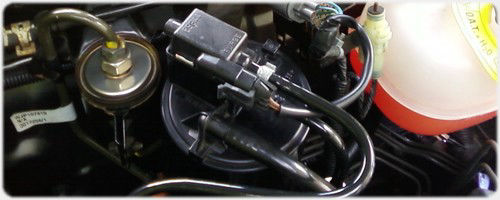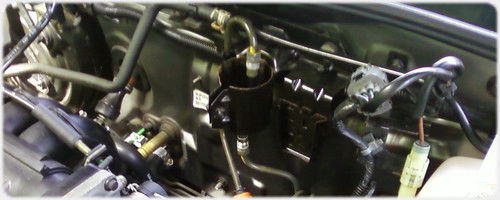
Fuel Filter Location
As shown, this item is fitted very close up to the charcoal canister making the filter a difficult removal and fitting process, also not wanting to cross thread the filters fittings.
With various aspects of servicing, maintenance, including driver assisted features and vehicle monitoring. For our 1996 Rover 200 and the 04 ZR 120+
About features, and driver notifications on our MG-Rover Information Pages
Overlooked and not changed for several years, dirty fuel filters seriously affects performance, including very bad idling issues, safety concerning the fuel system, so this was carried out on a cold engine as a precaution. The charcoal canister may restrict access to removal of the fuel filter, much easier if this is first removed. Also releasing the fuel filler cap for a few seconds, may reduce any pressure in the fuel lines?

As shown, this item is fitted very close up to the charcoal canister making the filter a difficult removal and fitting process, also not wanting to cross thread the filters fittings.

Makes for an easier working area with the charcoal canister out of the way, Once the bond between rubber gasket and the bulkhead bracket has been released.

To release the fuel filter unions a 14mm and 19mm open ended spanners were both used as shown. Then an 8mm spanner for releasing the fuel filter from the bulkhead holding clamp.
With the old filter now removed, new filter is placed in the clamp with fuel directional flow (arrow) pointing upwards, this is marked on side of the new fuel filter. Always found it good practice first securing both the top and bottom fuel pipe unions, this should centralise the fuel filter within the clamp, its all too easy to cross thread the filters brass fittings which can be a cause of subsequent fuel leakages.
To safeguard the above, usually doing up the fuel clamp holder's 8mm bolt the very last. prior to testing. the Halfords HFF-236 fuel filter that was used for this service, The new filter will need several seconds for it to prime on the very first start up of the engine, then its just one final check on each of the two fuel pipe unions for any leaks, prior to a good run out.
Information is referenced only to our 1996 Rover 200 and 2004 ZR 120+